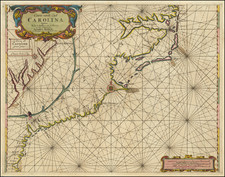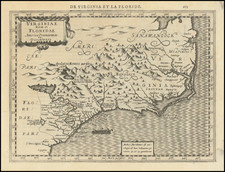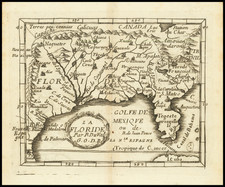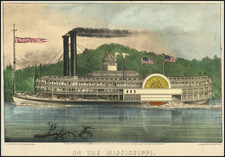A Unique Cartographic Artifact of Great Importance to the History of the American Midwest - the epic Hutchins map with extensive 1790s manuscript additions
The present map is a highly important and unique example of the fundamental eighteenth century cartographic record of the American Midwest. Filled with copious manuscript annotations in French, it was a working copy, evidently used by a French syndicate that invested in one or more of the various speculative land companies that dominated the region's history during the late eighteenth century. The accuracy and detail of the annotations indicates that they were done by persons who had access to the latest and most accurate information about conditions in the Midwest. The manuscript additions provide a wealth of information including the tracts of the various land companies, treaty lines, settlements, transportation routes, as well as terms of land sales and tenure.
As Hutchins'
A New Map of the Western Parts of Virginia was not only the best but also the largest map of the Midwest in print, it was the logical vehicle to educate such a syndicate about the region's geography. It shows the region between The Great Lakes and the Ohio River, west to the Mississippi, which was erected into the Northwest Territory in 1787, and immediately became the site of the most extensive land speculation in American history. A number of land companies were established in the Territory by prominent Americans, who immediately sought European, particularly French, investors to finance their projects. Their efforts coincided with the French Revolution, which resulted in a great flight of capital from France. The rapidly growing United States, with its abundant natural resources, seemed to offer the safe haven that French bankers, merchants and aristocrats were seeking.
While not properly appreciated today, the influx of European capital had a formative impact on the development of the Midwest. By the end of the eighteenth century, vast tracts of the U. S. backcountry including the Northwest Territory were owned by foreign investors, or reliant on foreign investment. As François Furstenberg notes in his remarkable analysis of the role of European capital in Frontier America:
[the] funneling of European capital into the northern and northwestern [American] backcountry may well be one of the most important -and most overlooked- features of the post-Revolutionary era , . . It was European capital, not American, that began to integrate the northern U. S. backcountry into the Atlantic world's trade networks.
Many of the American speculators were prominent politicians, such as Henry Knox, the Secretary of War, and Senator Robert Morris of Pennsylvania, which presumably insured that government policy would protect the interests of European capital. As such, the present map is a remarkable artifact of the inner workings of the marketing of America to such European investors, offering a unique visual insite into the Syndicate World.
Thomas Hutchins & the First Modern Mapping of the Midwest
Thomas Hutchins was one of the most important cartographers operating in America during the second half of the eighteenth-century. An intrepid frontier explorer of great intellectual curiosity, even more than two centuries later, the breadth and high quality of his work remains absolutely astonishing. Born in Monmouth County, New Jersey, Hutchins joined the Pennsylvania militia at a very young age, and evidently received advanced training in surveying and draftsmanship. During the French & Indian War he served at Fort Pitt, the gateway to the Ohio Country, and mapped the shorelines of much of the lower Great Lakes. Returning to Philadelphia, Hutchins was seconded to General Henry Bouquet's Expedition to reconnoiter the upper Ohio Valley, resulting in his fine M ap of the Country on the Ohio and Muskingum Rivers (1766). In 1766, he joined George Croghan and Harry Gordon on an epic descent of the Ohio to the Mississippi River, drafting a detailed hydrographic survey and making numerous scientific observations. He was subsequently charged with surveying the route of the proposed Iberville Canal, as well as various other locations in British West Florida.
In the mid-1770s, Hutchins drafted is groundbreaking and monumental manuscript map of the entire Trans-Appalachian West, A New Map of the Western part of Virginia. . . . It was the product of almost two decades of his own explorations combined with the finest available geographic intelligence gained from other authorities.
During the height of the American Revolution, Hutchins travelled to London in an effort to have his grand manuscript engraved and published, and became involved in the political intrigue that was gripping both sides of the Atlantic. While still technically serving as a British officer, a captain of the legendary 60th Regiment of Foot, Hutchins' loyalties increasingly lay with the Patriot cause. He crossed the channel to Paris, where he met Benjamin Franklin, who was then serving as the American ambassador to Versailles. Franklin, who was a leading speculator in Ohio Valley lands, was a great admirer of Hutchins' work. He also inducted Hutchins into the spy ring he was operating, the objective of which was to have well-placed American-sympathizers infiltrate official circles in London.
Hutchins promptly returned to London, and while he was arranging for the publication of his map, he fell under the suspicious gaze of William Knox, the Undersecretary of State for the Colonies. Knox (rightly) accused Hutchins of being an American spy and had the cartographer imprisoned and subjected to severe inquisition. Nevertheless, the great map was published towards the end of 1778, along with a separately issued descriptive pamphlet, A Topographical Description of Virginia, Pennsylvania, Maryland, and North Carolina.
Upon his release by the British, Hutchins travelled to Paris, where he met with Benjamin Franklin. Interestingly, and perhaps due to Franklin's intervention, in 1781, the prominent Paris mapmaker, Georges-Louis Le Rouge (who also published Franklin's map of the Gulf Stream), published a French edition of the great Hutchins map, along with an edition of the pamphlet entitled Description Topographique de la Virginie, de la Pensylvanie, du Maryland, et de la Caroline Septentrionale. The French edition of the pamphlet attained considerable importance, as it was seen as the authoritative guidebook to the American backcountry by French investors, which includes a map of the lands of the Indiana Company, which Hutchins dedicated to Benjamin Franklin and which is not found in the 1778 English edition of the pamphlet.
Hutchins was eventually returned to America. Following the Revolution, he was appointed as the first Geographer of the United States, whereupon he assumed a leading role in developing the frontier lands he had been instrumental in exploring. He was the father of the Ordinance Survey system, which established the systematic division of the western lands into neat cadastral squares (townships), and was actively involved in a series of private land speculation schemes. Hutchins died in 1789, while preparing to lead an ambitious speculative endeavor in Spanish Louisiana.
The Manuscript Annotations on the Hutchins Map
The present example of the Hutchins map is truly extraordinary, owing to the highly important and copious manuscript additions that adorn it throughout. The map was intensively consulted and heavily annotated by French land speculators operating in Europe. The manuscript augmentations were added between 1795 and 1797, and feature vast amounts of late-breaking information on the foundation of important cities, land speculation, transportation routes and the financial terms of land acquisition throughout the lower Great Lakes and the Ohio and upper Mississippi Valleys.
Beginning in Ohio, there is a manuscript line, denoted in yellow, that encompasses most of southern Ohio, which embraces the main tract of land of the Native American cession to the U.S. government as provided by the Treaty of Greenville of August 3, 1795. The cession is noted by a neat manuscript inscription written in an English hand.
In the corner of what is now southeastern Ohio, the 'Seven Ranges' are located (outlined in yellow), the first manifestation of the grid system of townships of the Ordinance Survey system, laid out in 1786-7 under the direction of Hutchins. Above, is a neat manuscript square, the 'Military Reserve' (outlined in dark blue); and to the south are the vast lands of the Ohio Company of Associates (outlined in pink), located along the Ohio River between the Seven Ranges and the Scioto River. This private concern, founded in Boston in 1786, gained the rights to a vast tract to the north of the Ohio River. This land would later be leased by the Ohio Company to various groups and would become embroiled in fraudulent and otherwise financially ill-fated investment schemes, while much of the territory that remained under its own auspices proved to be far less fertile than was originally assumed.
Within the Ohio Company Lands, manuscript annotations denote the land to the east as being "Ohio Comp 4 million d'acres", while to the west it reads "Scioto Comp 3 million d'acres". This refers to the Scioto Company, which was formed in 1787 by Colonel William Duer and several associates. It was reorganized in 1789 in Paris as the Compagnie du Scioto and focused on attracting French investors. The Company had arranged to purchase 4 million acres from the Ohio Company, occupying the western portion of their lands. For a time "Sciotomanie" spread through the salons of Paris, as many of the France's wealthiest and most esteemed figures enthusiastically invested in the endeavor.
However, the Scioto Company proved to be only one of Duer's several spectacular failures, ultimately defaulting on its payments to the Ohio Company. I n 1791, 218 French settlers arrived in Ohio to find that the Scioto Company was a chimera, and that no provisions had been made for their presence. Arriving in Marietta (founded in 1788), shown in manuscript on the map, the settlers were soon moved upriver to Gallipolis (also drawn in manuscript), a crude settlement that was created especially for them. Also added by hand is a trail running along the Ohio River along with the several forts, while the lengthy inscriptions surrounding the area give a detailed accounting of the amounts that were to be paid per acre for land sales in these regions.
A 1794 opinion by the U.S. Attorney General officially voided the Scioto Company's claims. On March 31, 1795, the U.S. Congress felt compelled to arrange for some form of restitution for the beleaguered French settlers, granting them 24,000 acres on the Ohio, just down river from the mouth of the Scioto. Elsewhere, French settlers were permitted to purchase the lands they occupied for $1.25 per acre.
Curiously, while the specific identity of the speculators who annotated the map is not known, extensive circumstantial suggests that they were likely involved in the former Scioto Company scheme. T he multiple hands that worked on the map in the French language show, through their detailed inscriptions, that they were clearly most concerned with the lands in what is now southeastern Ohio, especially the area once claimed by the Scioto Company. Moreover, as will be discussed later, the notes in the margins relating to land speculation in Maine further ties the present map into the circle of Duer and the Scioto scheme.
The map therefore seems to have been annotated by former Scioto speculators who, since the official collapse of the scheme in 1794, were trying to find a financially advantageous way forward in the region. The manuscript delineation of roads running from Pittsburgh overland to the Ohio River in modern West Virginia indicates that the speculators had an active interest in accessing the region, and that their curiosity was not merely 'armchair'.
In southwestern Ohio, between the Great and Little Miami Rivers, is the Symmes or "Miami Co" purchase, which is outlined in manuscript (in pink). In 1788, Colonel John Cleves Symmes purchased 2 million acres, although in 1794 the size of the grant was reduced to include only 350,000 acres. A hand written inscription on the map notes the 1788 purchase and the 200 families and 150 troops that had already arrived in the area. Fort Washington (founded 1789) is shown in manuscript to occupy the western bank of the Great Miami River. The notes above describes the transportation routes that traversed Ohio from Fort Washington to Lake Erie.
In northeastern Ohio, one can see the crude manuscript ink outline and labeling of the Connecticut Reserve. In 1786, these lands were formally claimed by the State of Connecticut based on the wording of its seventeenth-century colonial charter. In 1795, the state sold this reserve to a private concern, the Connecticut Land Company. Most interestingly, the site of Cleveland is noted (but not named) in manuscript at the mouth of the Cuyahoga River. Indeed, on July 22, 1796, Moses Cleaveland landed at the site and selected it as the place for a new town, which eventually bore his name (albeit misspelled). This is a very early designation of the site of Cleveland. This shows that the speculators who annotated this map were aware of events that transpired in the latter half of 1796.
Important to the history and development of the entire Midwest were the cessions of reserves, or enclaves, of territory as provided for by the Treaty of Greenville. These cessions were critical to securing the locations for the development of several key settlements, including Detroit and the future city of Chicago. These cessions are located throughout the region, and the sixteen reserves are depicted on the map in manuscript, colored in pink, and numbered so as to correspond to the official terms of the Greenville Treaty, which read as follows:
- One piece of land six miles square, at or near Loromie's store, before mentioned.
- One piece two miles square, at the head of the navigable water or landing, on the St. Mary's river, near Girty's town.
- One piece six miles square, at the head of the navigable water of the Auglaize river.
- One piece six miles square, at the confluence of the Auglaize and Miami rivers, where fort Defiance now stands. [Defiance, Ohio]
- One piece six miles square, at or near the confluence of the rivers St. Mary's and St. Joseph's, where Fort Wayne now stands, or near it. [Fort Wayne, Indiana]
- One piece two miles square, on the Wabash River, at the end of the portage from the Miami of the lake, and about eight miles westward from fort Wayne.
- One piece six miles square, at the Ouatanon, or Old Wea towns, on the Wabash river.
- One piece twelve miles square, at the British fort on the Miami of the lake, at the foot of the rapids.
- One piece six miles square, at the mouth of the said river, where it empties into the lake.
- One piece six miles square, upon Sandusky lake, where a fort formerly stood.
- One piece two miles square, at the lower rapids of Sandusky river.
- The post of Detroit, and all the land to the north, the west and the south of it, of which the Indian title has been extinguished by gifts or grants to the French or English governments: and so much more land to be annexed to the district of Detroit, as shall be comprehended between the river Rosine, on the south, lake St. Clair on the north, and a line, the general course whereof shall be six miles distant from the west end of lake Erie and Detroit river.
- The post of Michilimackinac, and all the land on the island on which that post stands, and the main land adjacent, of which the Indian title has been extinguished by gifts or grants to the French or English governments; and a piece of land on the main to the north of the island, to measure six miles, on lake Huron, or the strait between lakes Huron and Michigan, and to extend three miles back from the water of the lake or strait; and also, the Island De Bois Blane, being an extra and voluntary gift of the Chippewa nation.
- One piece of land six miles square, at the mouth of Chikago river, emptying into the southwest end of lake Michigan, where a fort formerly stood [site of Chicago, Illinois].
- One piece twelve miles square, at or near the mouth of the Illinois river, emptying into the Mississippi.
- One piece six miles square, at the old Piorias fort and village near the south end of the Illinois lake, on said Illinois river. And whenever the United States shall think proper to survey and mark the boundaries of the lands hereby ceded to them, they shall give timely notice thereof to the said tribes of Indians, that they may appoint some of their wise chiefs to attend and see that the lines are run according to the terms of this treaty.
The present map, with its manuscript additions, is also highly important to the early history of Illinois. The future location of downtown Chicago is contained within a manuscript box denoting it as Grenville Cession No.11. At the time that the map was annotated, the site was home to a small fort and farm that had been established by Jean Baptiste Point du Sable in the 1780s. While Du Sable's settlement would be abandoned in 1800, Fort Dearborn was established on the site in 1803, thus securing the area for the development of what would become America's third-largest city.
Outlined in brilliant manuscript color, several large proposed land concessions occupy what are now southern Illinois and a part of Indiana. The lands of the Illinois Company (outlined in pink) appear along the east bank Mississippi River above St. Louis, although the manuscript annotations on the map incorrectly designate the lands as belonging to the "[New] Jersey" Company. The actual New Jersey Company Lands (outlined in green) were in fact rather located to the south directly opposite St. Louis. In 1788, the merchant George Morgan applied for this large concession, but soon abandoned it in favor of founding the town of New Madrid (Missouri) in Spanish Louisiana.
Further to the south, the Army Reserve Lands (outlined in blue) occupy the territory between the Ohio and Mississippi Rivers above their confluence. A little to the northeast, the lands of the Illinois-Wabash Company (outlined in pink) straddle the Wabash River as it flows into the Ohio. This enterprise was founded in 1779, through the merger of the earlier Illinois and Wabash companies. Importantly, unlike the designs in Ohio, none of these early land speculation ventures in Illinois ever reached fruition. These lands generally lay outside of the Greenville cessions, and so occupied territory claimed by Native Americans. The land claims were thus never ratified, for Congress had no legal authority to grant them to applicants. It would be another two decades before new treaties would open up all of Illinois to European-American settlement.
Interestingly, the manuscript annotations along the Mississippi and Missouri Rivers allude to the 600 French families (French Canadian, as opposed to new French immigrants) that lived along the Mississippi between Cahokia and Kaskaskia. On the opposite bank, it notes that " beaucoup d'americains" (many Americans) have been given permission to settle on the Louisiana (Spanish) side of the Mississippi near St. Louis. Indeed, many Americans frustrated by their inability to gain land titles on their own side of the river, decided to chance their fortunes by applying to the Governor of Spanish Louisiana for permission to settle west of the Mississippi. Interestingly, these annotations coincide with the exact period in which Georges Henri Victor Collot was leading a secret French expedition down the Ohio and Mississippi rivers in the spring and summer of 1796, during which time he made maps and observed the Spanish and American fortifications and military preparedness.
To the northeast, in western New York, the lands of the Holland Land Company are traced in ink. Founded in 1789, the Holland Land Company obtained 3.25 million acres and was backed by prominent New York City figures, with funding from Amsterdam bankers. The annotations in the blank margin to the right of the map refer to land speculation schemes in upstate New York, most notably 'Macomb's Great Purchase', a sale of 4 million acres of land along the St. Lawrence River (beyond the confines of this map) in June 1791 to the New Yorkers "Mr. MacComb", "Mr. Constable" [Alexander Macomb and William Constable] and "Le gouverneur Clinton" [George Clinton, the first governor of New York]. In 1792, Constable, a prominent New York politician and banker, made a trip to Europe to dispose of these lands but was only partially successful. It would seem that the individuals who annotated that map were perhaps among the objects of Constable's overtures.
Also noted in manuscript in the margins is General Henry Knox and Colonel Duer's scheme to develop two million acres in the state of Maine. This scheme was highly leveraged with debt, and while attempts were made to attract European investment, the scheme proved to be largely unsuccessful. The reference to the Maine project is important to the overall picture, for it further ties the individuals who annotated the present map into the Duer's Scioto circle.
Conclusion
In summary, the present example of Hutchins' epic work, with its extensive 1790s manuscript additions, is an exceedingly important historical artifact documenting the early endeavors to settle the American Midwest. With unrivalled scope and detail, it depicts the Native American cessions, key transportation routes and settlements and virtually all of the major land speculation schemes in both the Ohio and Illinois regions, all laid down by the hands of individuals who participated in these designs. Importantly, it also serves as evidence to the leading role European investors played in the development of the Midwest in the wake of the American Revolution.
The present map is one of only two known examples of the great Hutchins map to feature early manuscript additions, the other having been offered at auction at Swann Galleries on June 19, 2008. The present example is superior, for it features far richer detail in its manuscript additions, especially with respect to its depiction of the Illinois country.













![[First Map of the Mississippi River] Carte de la decouverte faite l'an dans l'Amerique Septentrionale](https://storage.googleapis.com/raremaps/img/small/93571.jpg)
